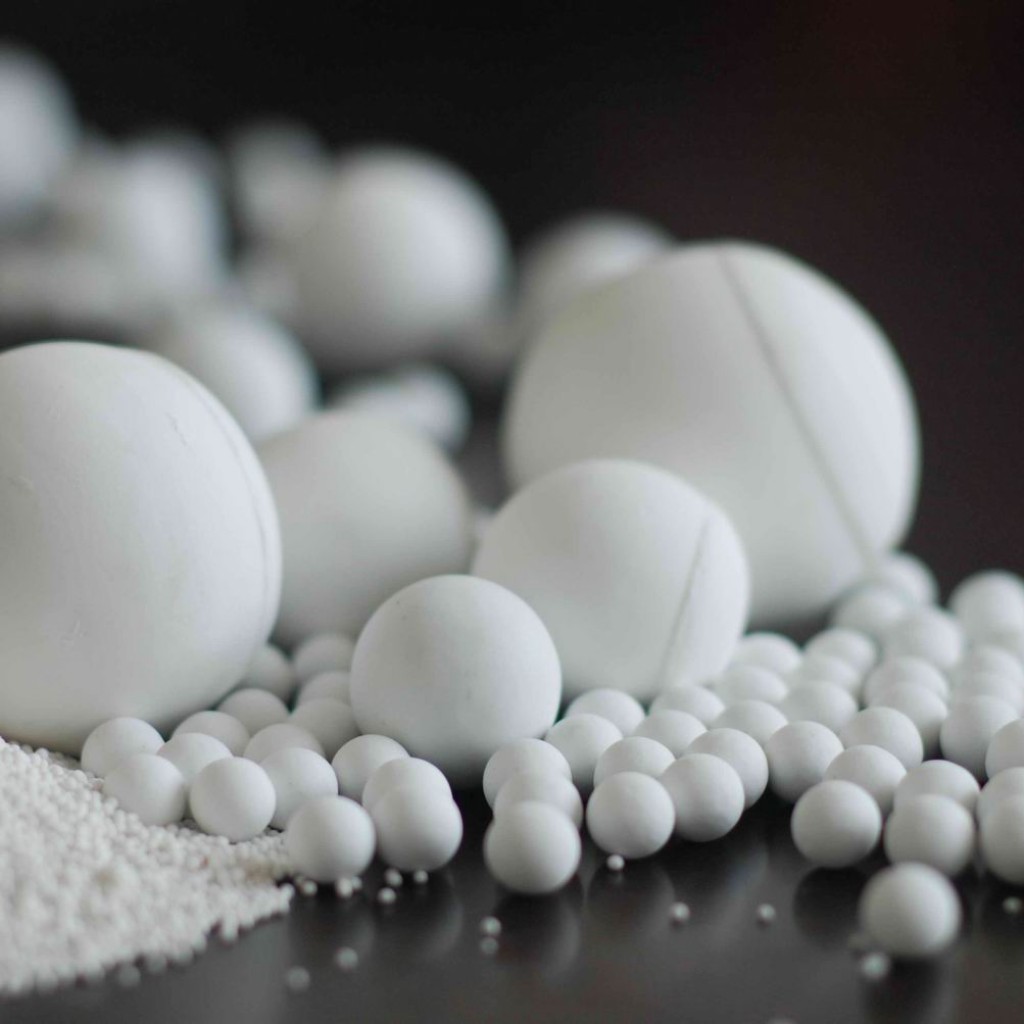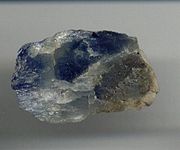ABOUT AL203
UK & Europe wide.
Natural occurrence
Corundum is the most common naturally occurring crystalline form of aluminium oxide. Rubies and sapphires are gem-quality forms of corundum, which owe their characteristic colors to trace impurities. Rubies are given their characteristic deep red color and their laser qualities by traces of chromium. Sapphires come in different colors given by various other impurities, such as iron and titanium.
Properties
Aluminium oxide in its powdered form.
Al2O3 is an electrical insulator but has a relatively high thermal conductivity (30 Wm−1K−1) for a ceramic material. Aluminium oxide is insoluble in water. In its most commonly occurring crystalline form, called corundum or α-aluminium oxide, its hardness makes it suitable for use as an abrasive and as a component in cutting tools.
Aluminium oxide is responsible for the resistance of metallic aluminium to weathering. Metallic aluminium is very reactive with atmospheric oxygen, and a thin passivation layer of aluminium oxide (4 nm thickness) forms on any exposed aluminium surface. This layer protects the metal from further oxidation. The thickness and properties of this oxide layer can be enhanced using a process called anodising. A number of alloys, such asaluminium bronzes, exploit this property by including a proportion of aluminium in the alloy to enhance corrosion resistance. The aluminium oxide generated by anodising is typically amorphous, but discharge assisted oxidation processes such as plasma electrolytic oxidation result in a significant proportion of crystalline aluminium oxide in the coating, enhancing its hardness. It is commonly used in precision ceramics uk and semiconductors uk.



Amphoteric nature
Aluminium oxide is an amphoteric substance, meaning it can react with both acids and bases, such as hydrofluoric acid and sodium hydroxide, acting as an acid with a base and a base with an acid, neutralising the other and producing a salt.
- Al2O3 + 6 HF → 2 AlF3 + 3 H2O
- Al2O3 + 6 NaOH + 3 H2O → 2 Na3Al(OH)6 (sodium aluminate)
Structure
Corundum from Brazil, size about 2×3 cm.
The most common form of crystalline aluminium oxide is known as corundum, which is the thermodynamically stable form. The oxygen ions nearly form a hexagonal close-packed structure with aluminium ions filling two-thirds of the octahedral interstices. Each Al3+ center is octahedral. In terms of its crystallography, corundum adopts a trigonal Bravais lattice with a space group of R-3c (number 167 in the International Tables). The primitive cell contains two formula units of aluminium oxide.
Aluminium oxide also exists in other phases, including the cubic γ and η phases, the monoclinic θ phase, the hexagonal χ phase, the orthorhombic κ phase and the δ phase that can be tetragonal or orthorhombic. Each has a unique crystal structure and properties. Cubic γ-Al2O3 has important technical applications. The so-called β-Al2O3 proved to be NaAl11O17.
Molten aluminium oxide near the melting temperature is roughly 2/3 tetrahedral (i.e. 2/3 of the Al are surrounded by 4 oxygen neighbors), and 1/3 5-coordinated, very little (<5%) octahedral Al-O is present. Around 80% of the oxygen atoms are shared among three or more Al-O polyhedra, and the majority of inter-polyhedral connections are corner-sharing, with the remaining 10–20% being edge-sharing. The breakdown of octahedra upon melting is accompanied by a relatively large volume increase (~20%), the density of the liquid close to its melting point is 2.93 g/cm3.
Production
Aluminium hydroxide minerals are the main component of bauxite, the principal ore of aluminium. A mixture of the minerals comprise bauxite ore, including gibbsite (Al(OH)3), boehmite (γ-AlO(OH)), and diaspore (α-AlO(OH)), along with impurities of iron oxides and hydroxides, quartz and clay minerals. Bauxites are found in laterites. Bauxite is purified by the Bayer process:
- AlO(OH) + H2O + NaOH → NaAl(OH)4
- Al(OH)3 + NaOH → NaAl(OH)4
Except for SiO2, the other components of bauxite do not dissolve in base. Upon filtering the basic mixture, Fe2O3 is removed. When the Bayer liquor is cooled, Al(OH)3 precipitates, leaving the silicates in solution.
- NaAl(OH)4 → NaOH + Al(OH)3
The solid Al(OH)3 Gibbsite is then calcined (heated strongly) to give aluminium oxide:
- 2 Al(OH)3 → Al2O3 + 3 H2O
The product aluminium oxide tends to be multi-phase, i.e., consisting of several phases of aluminium oxide rather than solely corundum. The production process can therefore be optimized to produce a tailored product. The type of phases present affects, for example, the solubility and pore structure of the aluminium oxide product which, in turn, affects the cost of aluminium production and pollution control.
For its application as an electrical insulator in integrated circuits, where conformal growth of thin film is a prerequisite and the preferred growth mode is atomic layer deposition, Al2O3 films were prepared by the chemical exchange between trimethylaluminum Al(CH3)3 and H2O:
- 2 Al(CH3)3 + 3 H2O → Al2O3 + 6 CH4
H2O in the above reaction was subsequently replaced by ozone (O3) as the active oxidant and the following reaction took place:
- 2 Al(CH3)3 + O3 → Al2O3 + 3 C2H6
The Al2O3 films prepared using O3 show 10–100 times lower leakage current density compared with those prepared by H2O.
Known as alundum (in fused form) or aloxite in the mining, ceramic, and materials science communities, aluminium oxide finds wide use. Annual world production of aluminium oxide is approximately 45 million tonnes, over 90% of which is used in the manufacture of aluminium metal. The major uses of specialty aluminium oxides are in refractories, ceramics, and polishing and abrasive applications. Large tonnages are also used in the manufacture of zeolites, coating titania pigments, and as a fire retardant/smoke suppressant.
Applications
The great majority of aluminium oxide is consumed for the production of aluminium, usually by the Hall–Héroult process.
Filler
Being fairly chemically inert and white, aluminium oxide is a favored filler for plastics. Aluminium oxide is a common ingredient in sunscreen and is sometimes present in cosmetics such as blush, lipstick, and nail polish.
Catalysis
Aluminium oxide catalyses a variety of reactions that are useful industrially. In its largest scale application, aluminium oxide is the catalyst in the Claus process for converting hydrogen sulfide waste gases into elemental sulfur in refineries. It is also useful for dehydration of alcohols to alkenes.
Aluminium oxide serves as a catalyst support for many industrial catalysts, such as those used in hydrodesulfurization and some Ziegler-Natta polymerizations.
Purification
Aluminium oxide is widely used to remove water from gas streams. Other major applications are described below.
Abrasive
Aluminium oxide is used for its hardness and strength. It is widely used as an abrasive, including as a much less expensive substitute for industrial diamond. Many types of sandpaper use aluminium oxide crystals. In addition, its low heat retention and low specific heat make it widely used in grinding operations, particularly cutoff tools. As the powdery abrasive mineral aloxite, it is a major component, along with silica, of the cue tip “chalk” used in billiards. Aluminium oxide powder is used in some CD/DVD polishing and scratch-repair kits. Its polishing qualities are also behind its use in toothpaste. Aluminium oxide can be grown as a coating on aluminium by anodising or by plasma electrolytic oxidation (see the “Properties” above). Both its strength and abrasive characteristics originate from the high hardness (9 on the Mohs scale of mineral hardness) of aluminium oxide.
Paint
Composite fiber
Aluminium oxide has been used in a few experimental and commercial fiber materials for high-performance applications (e.g., Fiber FP, Nextel 610, Nextel 720). Alumina nanofibers in particular have become a research field of interest.
Aluminum oxide is used as catalyst for the decomposition of hydrazine in Chemical-reaction Monopropellant rockets.
In lighting, transparent aluminium oxide is used in some sodium vapor lamps. Aluminium oxide is also used in preparation of coating suspensions in compact fluorescent lamps.
In chemistry laboratories, aluminium oxide is a medium for chromatography, available in basic (pH 9.5), acidic (pH 4.5 when in water) and neutral formulations.
Health and medical applications include it as a material in hip replacements.
As well, it is used as a dosimeter for radiation protection and therapy applications for its optically stimulated luminescence properties.
Aluminium oxide is an electrical insulator used as a substrate (silicon on sapphire) for integrated circuits but also as a tunnel barrier for the fabrication of superconducting devices such assingle electron transistors and superconducting quantum interference devices (SQUIDs).
Insulation for high-temperature furnaces is often manufactured from aluminium oxide. Sometimes the insulation has varying percentages of silica depending on the temperature rating of the material. The insulation can be made in blanket, board, brick and loose fiber forms for various application requirements.
Small pieces of aluminium oxide are often used as boiling chips in chemistry.
It is also used to make spark plug insulators.
Using a plasma spray process and mixed with titania, it is coated onto the braking surface of some bicycle rims to provide abrasion and wear resistance.
Most ceramic eyes on fishing rods are circular rings made from aluminum oxide.
It is commonly used in precision ceramics uk and semiconductors uk.
At ACE Precision Ceramics UK – We utilise AL203 for the production of semiconductors and alumina components in UK and Europe.
- We supply UK & Europe wide
- 40 Years Experience
- Wide range of solutions
